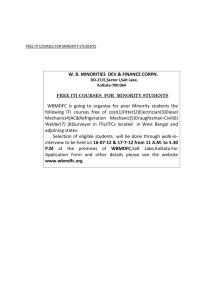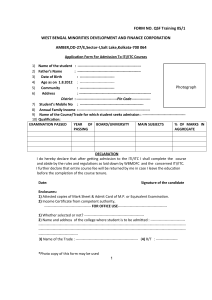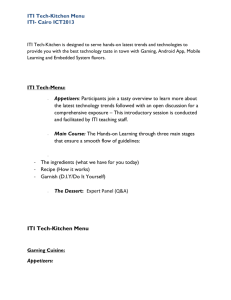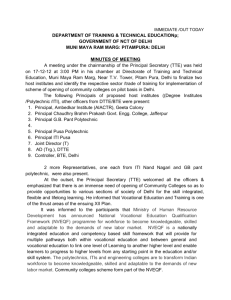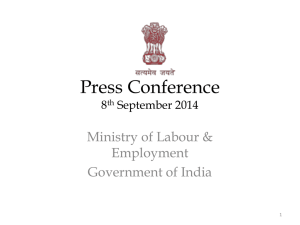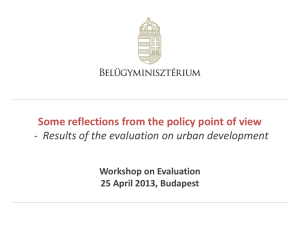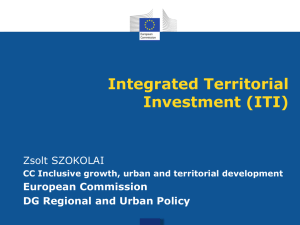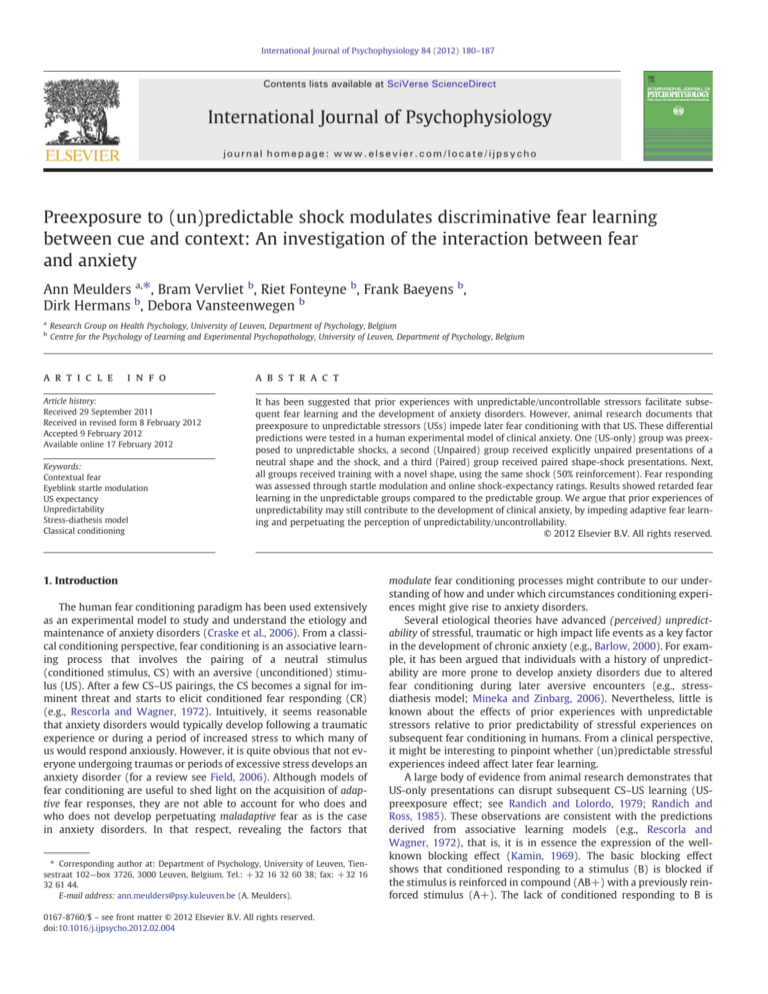
International Journal of Psychophysiology 84 (2012) 180–187
Contents lists available at SciVerse ScienceDirect
International Journal of Psychophysiology
journal homepage: www.elsevier.com/locate/ijpsycho
Preexposure to (un)predictable shock modulates discriminative fear learning
between cue and context: An investigation of the interaction between fear
and anxiety
Ann Meulders a,⁎, Bram Vervliet b, Riet Fonteyne b, Frank Baeyens b,
Dirk Hermans b, Debora Vansteenwegen b
a
b
Research Group on Health Psychology, University of Leuven, Department of Psychology, Belgium
Centre for the Psychology of Learning and Experimental Psychopathology, University of Leuven, Department of Psychology, Belgium
a r t i c l e
i n f o
Article history:
Received 29 September 2011
Received in revised form 8 February 2012
Accepted 9 February 2012
Available online 17 February 2012
Keywords:
Contextual fear
Eyeblink startle modulation
US expectancy
Unpredictability
Stress-diathesis model
Classical conditioning
a b s t r a c t
It has been suggested that prior experiences with unpredictable/uncontrollable stressors facilitate subsequent fear learning and the development of anxiety disorders. However, animal research documents that
preexposure to unpredictable stressors (USs) impede later fear conditioning with that US. These differential
predictions were tested in a human experimental model of clinical anxiety. One (US-only) group was preexposed to unpredictable shocks, a second (Unpaired) group received explicitly unpaired presentations of a
neutral shape and the shock, and a third (Paired) group received paired shape-shock presentations. Next,
all groups received training with a novel shape, using the same shock (50% reinforcement). Fear responding
was assessed through startle modulation and online shock-expectancy ratings. Results showed retarded fear
learning in the unpredictable groups compared to the predictable group. We argue that prior experiences of
unpredictability may still contribute to the development of clinical anxiety, by impeding adaptive fear learning and perpetuating the perception of unpredictability/uncontrollability.
© 2012 Elsevier B.V. All rights reserved.
1. Introduction
The human fear conditioning paradigm has been used extensively
as an experimental model to study and understand the etiology and
maintenance of anxiety disorders (Craske et al., 2006). From a classical conditioning perspective, fear conditioning is an associative learning process that involves the pairing of a neutral stimulus
(conditioned stimulus, CS) with an aversive (unconditioned) stimulus (US). After a few CS–US pairings, the CS becomes a signal for imminent threat and starts to elicit conditioned fear responding (CR)
(e.g., Rescorla and Wagner, 1972). Intuitively, it seems reasonable
that anxiety disorders would typically develop following a traumatic
experience or during a period of increased stress to which many of
us would respond anxiously. However, it is quite obvious that not everyone undergoing traumas or periods of excessive stress develops an
anxiety disorder (for a review see Field, 2006). Although models of
fear conditioning are useful to shed light on the acquisition of adaptive fear responses, they are not able to account for who does and
who does not develop perpetuating maladaptive fear as is the case
in anxiety disorders. In that respect, revealing the factors that
⁎ Corresponding author at: Department of Psychology, University of Leuven, Tiensestraat 102—box 3726, 3000 Leuven, Belgium. Tel.: + 32 16 32 60 38; fax: + 32 16
32 61 44.
E-mail address: ann.meulders@psy.kuleuven.be (A. Meulders).
0167-8760/$ – see front matter © 2012 Elsevier B.V. All rights reserved.
doi:10.1016/j.ijpsycho.2012.02.004
modulate fear conditioning processes might contribute to our understanding of how and under which circumstances conditioning experiences might give rise to anxiety disorders.
Several etiological theories have advanced (perceived) unpredictability of stressful, traumatic or high impact life events as a key factor
in the development of chronic anxiety (e.g., Barlow, 2000). For example, it has been argued that individuals with a history of unpredictability are more prone to develop anxiety disorders due to altered
fear conditioning during later aversive encounters (e.g., stressdiathesis model; Mineka and Zinbarg, 2006). Nevertheless, little is
known about the effects of prior experiences with unpredictable
stressors relative to prior predictability of stressful experiences on
subsequent fear conditioning in humans. From a clinical perspective,
it might be interesting to pinpoint whether (un)predictable stressful
experiences indeed affect later fear learning.
A large body of evidence from animal research demonstrates that
US-only presentations can disrupt subsequent CS–US learning (USpreexposure effect; see Randich and Lolordo, 1979; Randich and
Ross, 1985). These observations are consistent with the predictions
derived from associative learning models (e.g., Rescorla and
Wagner, 1972), that is, it is in essence the expression of the wellknown blocking effect (Kamin, 1969). The basic blocking effect
shows that conditioned responding to a stimulus (B) is blocked if
the stimulus is reinforced in compound (AB+) with a previously reinforced stimulus (A+). The lack of conditioned responding to B is
A. Meulders et al. / International Journal of Psychophysiology 84 (2012) 180–187
typically attributed to the fact that the US is fully predicted by A, as a
result there is no incentive to learn the B–US association during the
compound training. By analogy, in absence of discrete predictors
(CSs) for the US, the context will gain associative strength producing
conditioned responding to the context which subsequently blocks
new (cued) fear conditioning (context blocking; Tomie, 1976).
According to this context blocking hypothesis, processes of cue competition between the contextual cues and the new discrete CS result in
reduced discriminative fear learning between cue and context when
tested in the same context.
In the present study, we employed a human fear conditioning
paradigm with a shock as US, geometrical shapes as CSs, and contexts were created by displaying a picture as a background on the
computer screen (see procedure Fonteyne et al., 2009). Dependent
variables were online shock-expectancy ratings and eyeblink startle
modulation, the latter indexing cued fear when measured during
the CS and indexing more chronic anticipatory anxiety when measured during the context alone (i.e., intertrial interval; ITI). The
main question of interest of our study was whether prior (un)predictability experiences can modulate fear conditioning to a novel
(CS) shape. An important strength of the present design is the
fact that we used two unpredictable groups. In human conditioning
research, unpredictable traumatic experiences are often modeled by
delivering unsignaled shocks and CSs in an explicitly unpaired manner (Fonteyne et al., 2009; Grillon, 2002; Vansteenwegen et al.,
2008). In animal research, however, US-only presentations are
mostly used to produce US-unpredictability (Fanselow, 1980a,
1980b). Remarkably, possible divergent effects of these two USunpredictability procedures have never been compared systematically in a human fear conditioning preparation. To monitor the effects of US-unpredictability more closely, two unpredictable
groups were included, namely, the Unpaired group and the USonly group. During the shock-preexposure phase, both unpredictable
groups repeatedly received unpredictable shocks: the Unpaired
group received explicitly unpaired CS1/US presentations, while the
US-only group received temporally unpredictable USs in the absence of any discrete cues. In the predictable (Paired) group signaled shocks (immediately after CS1 offset) were presented. ITI
levels of both startle responses and online shock-expectancy ratings
were expected to be elevated during the unpredictable shockpreexposure procedures (i.e., contextual fear) compared with the
predictable shock-preexposure procedure. Following the safety signal hypothesis (Seligman and Binik, 1977), we also hypothesized
that in the US-only group more fear would accrue to the context
than in the Unpaired group (expressed in higher ITI responses), because in the former group safety signals (i.e. CS−) offering short
periods of relief are absent. Next, all three groups received a cued
fear conditioning procedure with a novel (50% reinforced) CS2 in
the same experimental context. We expected less discriminative
CS/ITI learning in the unpredictable groups (at least in the beginning of the cued fear conditioning phase) due to remaining elevated ITI responses (i.e. contextual fear). In addition, we expected that
more contextual fear would induce more contextual blocking and
thus lead to worse discriminative CS/ITI learning in the US-only
group than in the Unpaired group.
2. Method
2.1. Participants
A total of sixty-seven first-year healthy subjects including 35
economy students and 32 psychology students at the University of
Leuven (27 males and 40 females) were invited to participate in the
experiment in return for course credit. Their mean age was 18 years
(ranging from 17 to 20). All participants gave written informed consent and were instructed that they were allowed to decline
181
participation at any time during the experiment. The experimental
protocol was approved by the Ethical Committee of the Department
of Psychology.
2.2. Apparatus and experimental stimuli
2.2.1. Software
The entire experiment was run on a Windows XP computer with
256 Mb RAM and an AMD Athlon K7 processor (Pentium III class
compatible) at 600 MHz and was programmed using Affect (version
4.0) developed by Hermans et al. (2005); see also Spruyt et al. (2010).
2.2.2. Shock-expectancy ratings
The expectancy of the shock-US was measured online using a custom built dial operated by the participants' right hand. Participants
were instructed to indicate continuously throughout the experiment
to what extent they expected the shock-US to occur. The pointer
could be turned through 180° from 0 to 100, ‘0’ indicating that the
participant did not at all expect the shock to occur, and ‘100’ indicating that the participant certainly expected the shock to occur. The
custom-made expectancy dial generated an online analog signal
that was digitized at 10 Hz by an A/D converter and saved on the
computer.
2.2.3. Startle measurement
Orbicularis Oculi electromyographic activity (EMG) was recorded
with three Ag/AgCl Sensormedics electrodes (0.25 cm diameter)
filled with a TECA electrolyte. After cleaning the skin with a peeling
cream to reduce inter-electrode resistance, electrodes were placed
on the left side of the face according to the site specifications proposed by Fridlund and Cacioppo (1986). The raw signal was amplified
by a Coulbourn isolated bioamplifier with bandpass filter (v75-04).
The recording bandwidth of the EMG signal was between 10 Hz and
20 kHz (±3 dB). The signal was rectified online and smoothed by a
Coulbourn multifunction integrator (v76-23A) with a time constant
of 50 ms. In the startle probe presentations, signal measuring started
1 s before probe onset at 1000 Hz. From probe onset, the signal was
digitized at 1000 Hz for 1000 ms. The startle probe was a 100 dBA
burst of white noise with instantaneous rise time presented binaurally for 50 ms through headphones.
2.2.4. Stimulus material
In line with the procedure of Fonteyne et al. (2009), a picture of a
room was continuously presented on the background of the computer
screen to serve as the experimental context. Three geometrical
shapes (black drawings of a circle, a triangle, and a star) were used
as CSs and presented in the centre of the computer screen on top of
the background picture. An electrocutaneous shock of 2 ms duration
serving as the US was delivered by a commercial stimulator for percutaneous stimulation (DS7A, Digitimer, Welwyn Garden City, England)
through surface Sensormedics electrodes (1 cm diameter) filled with
K-Y gel that were attached to the left wrist. During the shock calibration procedure (mean shock intensity was 23.32 mA, SD = 12.79) the
participants were asked to rate the shock-US on a scale ranging from
1 to 10 with the anchors ‘1’, ‘2’ and ‘10’ respectively meaning “You feel
something but it is not painful, it is merely a sensation”, “It starts to be
painful but it is still a very small pain”, and “This stimulation is the maximum tolerable pain for you in this experiment”. When reaching the
highest individual level tolerated by the participant, the experimenter
asked whether s/he thought s/he would be able to tolerate repeated
shocks of this amplitude during the experiment. Notice that during
this shock calibration procedure, participants were instructed to notify the experimenter when they did not want to proceed receiving the
shock of higher intensity or if they wanted the amplitudes to be set
back at a lower level.
182
A. Meulders et al. / International Journal of Psychophysiology 84 (2012) 180–187
2.2.5. Experimental setting
Participants were seated in an armchair (0.6 m screen distance) in
a sound-attenuated experimental room, adjacent to the experimenter's room. Further verbal communication was possible through an
intercom system. During the course of the experiment, the central
lighting was turned off; however, dimmed light was available.
2.3. Procedure
The experiment was conducted during a single one-hour session
and consisted of a preparation phase, a startle habituation phase, a
CS habituation phase, a shock-preexposure phase, and a cued learning
phase. For all participants, a circle (CS1) was presented during the
shock-preexposure phase. Half of the participants received a star as
the CS2 (cued learning phase) and the other half received a triangle
as the CS2 (see Table 1 for a summary of the experimental design).
2.3.1. Preparation phase
Participants were informed (orally and in writing) that electrocutaneous shocks and unpleasant loud noises would be administered
and that their main task was to predict the occurrence of the shockUS. Upon signing the informed consent form participants went to
the sound-attenuated experimental room where they were
instructed how to operate the online shock-expectancy dial. Next,
the startle measurement electrodes were attached. After placing the
stimulation electrodes, the intensity level of the shock-US was selected following the shock calibration procedure (see Stimulus material
section). Finally, the headphones were put on, and the lights in the
experimental room were dimmed. Note that participants were not informed about the contingencies between the background pictures
(context), the geometrical shapes (CSs), and the shock-US.
2.3.2. Startle habituation phase
A habituation phase was included to prevent possible confounds
in the data because the first startles to the probes are relatively
large. The habituation phase contained eight trials, each lasting for
32 s (with a variable ITI of on average 5 s (±2 s)). During each trial,
one startle probe is presented, either at 1 s, 2 s, 14 s, 15 s, 17 s, 18 s,
25 s, and 27 s after trial onset. In this phase, no shock-USs were presented, the background picture serving as the context was continuously presented on the screen and the order of the trials was
randomized across participants.
2.3.3. CS habituation phase
In order to obtain an index of baseline startle responding before
conditioning, we presented four trials (lasting for 32 s with a variable
Table 1
Summary of the experimental design.
Group
Habituation CS habituation Shock-preexposure Cued learning
phase
phase
phase
phase
8 trials
Paired group
(n = 23)
Unpaired
group
(n = 23)
US-only
group
(n = 21)
4 trials
2 blocks of 4 trials
3 blocks of
4 trials
8 × paired CS1–US
8 probes
2 CS1 probes
8 × unpaired
CS1/US
2 ITI probes
6 × CS2-only
6 × paired
CS2–US
8 US-only
Note. CSs were neutral geometrical shapes and the US was an electrocutaneous shock.
For all participants the CS1 was a circle, whereas a triangle and a star were counterbalanced to serve as the CS2. During the cued learning phase, the presentation order of
the different trial types (CS2-only and paired CS2–US) was randomized within each
block.
ITI of on average 5 s (±2 s)), each trial consisting of one CS1 presentation. At the 9th second of each trial, the CS was presented for 8 s on
top of the background picture serving as the context. In two of these
CS1 trials, the startle probe was presented 5–6 s after the onset of the
CS (CS-probe) and for the other two CS1 trials, a startle probe was
presented during the ITI (8–6 s before the CS onset or 8–10 s after
the CS offset). No shocks were presented in this phase and the order
of the trials was randomized across participants.
2.3.4. Shock-preexposure phase
This phase comprised two blocks of four trials. A trial consisted of
an ITI of 29 s and a CS1 presentation of 8 s. The ITI consisted of a post
CS-interval of 16 s, a variable ITI of on average 5 s (±2 s) and a preCS-interval of 8 s. In the Paired group, the shock-US was presented
immediately after CS1 offset. In the Unpaired group, the shock-US
was delivered either at 7.5 s before CS1 onset, 5.5 s before the CS1
onset, 8.5 s after CS1 offset or 10.5 s after the CS1 offset. Note that
the Unpaired group is an adequate control for the Paired group
since the number of shock-US and CS presentations are being kept
constant, and only the CS–US contingency is varied. In each block of
four CS presentations, two startle probes were presented during the
CS (5 and 6 s after CS onset) and two during the ITI (one probe position before the CS and one probe position after the CS).
To avoid startle facilitation during ITI being confounded by direct
reactions to presentations of the shock-US, in the Unpaired group,
startle probes were presented before the CS when the shock-US was
presented after the CS and after the CS when the shock-US was presented before. Finally, in the US-only group, US-only presentations
and startle probes followed the same time schedule as in the Unpaired group, however, no CSs were presented.
2.3.5. Cued learning phase
The cued learning phase consisted of three blocks of four learning
trials. Basically, trials were built up the same way as described above.
In this phase, however, the shock-US was presented only in half of the
trials (50% reinforced CS2)—this reinforcement schedule was chosen
in order to avoid early ceiling effects. For all groups, in two trials the
shock-US was presented immediately after CS2 offset. In two other
trials the CS2 was presented without the shock-US. In each block of
four CS presentations, two startle probes were presented during the
CS (5 and 6 s after CS onset) and two during the ITI (one probe position before the CS and one probe position after the CS). For all participants, the presentation order of the different trial types was
randomized within each block.
2.4. Response definition
2.4.1. Startle response
Using PSPHA (De Clercq et al., 2006), a modular script-based program, we calculated the peak amplitudes defined as the maximum of
the response curve within 21–175 ms after the startle probe onset. All
startle waveforms were visually inspected offline and technical abnormalities and artifacts were eliminated using the PSPHA software.
Every peak amplitude was scored by subtracting its baseline score
(averaged EMG level between 1 and 20 ms after the noise probe
onset). The raw scores were transformed to z-scores to account for
inter-individual differences in physiological reactivity. In order to optimize the visualization of the startle data and avoid negative values
on the Y-axis, T-scores—a linear transformation of the z-scores—
were used in the figures. Averages were calculated for responding
during CS and ITI separately for the Paired, Unpaired, and US-only
groups.
2.4.2. Shock-expectancy ratings
Shock-expectancy was measured online during all trials from 8 s
before CS onset until 16 s after CS offset. This 32-s period was
A. Meulders et al. / International Journal of Psychophysiology 84 (2012) 180–187
subdivided in 32 units of 1 s and for each unit the mean shockexpectancy rating was calculated using PSPHA. Fig. 1 shows an overview of the means for all 32 s separately for the three experimental
groups for the shock-preexposure phase (Blocks 1–2) and the cued
learning phase (Blocks 1–3). The means used in the statistical analyses below are the means of the 16th and the 28th second. The former is an index of conditioned shock-expectancy elicited during the
last second of the CS and immediately before the predictable USs
are presented, while the latter was selected as the most pure measure
of shock-expectancy elicited during the ITI (a block that was not contaminated by probe or shock-US presentation).
183
[Stimulus Type (CS/ITI) × Group (Paired/Unpaired/US-only)] RM
ANOVA. Planned comparisons were used to further inspect the CS/
ITI differences between the predictable vs. unpredictable groups and
within each group. In order to evaluate discriminative fear learning
between cue and context at the end of the cued learning phase, we analyzed responses on both dependent measures during Block 3 with a
2 × 3 [Stimulus Type (CS/ITI) × Group (Paired/Unpaired/US-only)] RM
ANOVA. Again, planned comparisons were used to inspect the CS/ITI
differences between the predictable vs. unpredictable groups and
within each group.
3. Results
2.5. Data-analysis overview
3.1. Descriptive statistics of the shock-US
Below, the data will be presented separately for both dependent
measures. For startle modulation, the statistical analysis was run on
a total of 61 participants: Five participants were excluded due to technical failures, and for one participant not all means could be calculated due to a series of missing data (nPaired = 20; nUnpaired = 21;
nUS-only = 20). The α-level was set at .05 for all statistical tests. Following Kirk (1995), mean square error terms and degrees of freedom
appropriate for the specific contrasts were used. Bonferroni-corrected
α-levels are used for multiple comparisons.
2.5.1. Shock-preexposure phase
Online shock-expectancy ratings and fear-potentiated startle responses for cues (CS) and cue-free context (ITI) were averaged per
block, separately for the Paired, Unpaired and US-only groups. Both
dependent measures were analyzed using a 2 × 2 × 3 repeated measures (RM) ANOVA with Stimulus Type (CS/ITI) and Block (1/2) as
within-subjects factors and Group (Paired/Unpaired/US-only) as
between-subjects factor. Given the specific a priori hypotheses,
planned comparisons were used to further analyze the ITI differences
between the predictable vs. unpredictable groups.
2.5.2. Cued learning phase
Shock-expectancy ratings and fear-potentiated startle responses
during CS and ITI were again averaged per block, separately for the
Paired, Unpaired and US-only groups. Because we expected the anticipated effects of unpredictable shocks on later fear learning to be
most pronounced in the beginning of this phase, we analyzed responses on both dependent measures during Block 1 with a 2 × 3
Preliminary analyses showed no gender differences for any of the
variables; thus this factor was omitted in the statistical data analysis.
However, men and women did differ significantly with respect to
shock intensity, F(1, 65) = 14.65, p b .001: men (M = 30.11 mA,
SD = 2.25, n = 27) typically selected higher shock levels than women
(M = 18.98 mA, SD = 1.85, n = 40). There were, however, no significant differences in mean shock intensity between the three groups,
F b 1, (MPaired = 24.13 mA, SD = 2.66, n = 23; MUnpaired = 22.57 mA,
SD = 2.84, n = 23; MUS-only = 23.59 mA, SD = 2.77, n = 21).
3.2. Shock-expectancy ratings
3.2.1. Shock-preexposure phase: manipulation check
It was predicted that context conditioning would emerge in the
groups that were exposed to unpredictable shocks (Unpaired and
US-only), but not in the group (Paired) exposed to predictable shocks.
As can be seen in Fig. 2A, shock-expectancies during the ITI (i.e., context conditioning) gradually increased in the unpredictable groups
(Unpaired and US-only) compared with the predictable (Paired)
group.
Of crucial importance, the statistical analysis revealed a significant
3-way interaction, F(2, 64) = 12.61, p b .001, ηp2 = .28, confirming that
CS/ITI differences increased over blocks in function of group. Planned
between-group comparisons on the ITI alone at the end of the shockpreexposure phase confirmed that the shock-expectancy ratings during
the ITIs in the unpredictable groups (Unpaired and US-only) were
higher than in the predictable group (Paired), F(1, 64) = 15.66,
Fig. 1. Mean shock-expectancy ratings during the preexposure phase (Blocks 1–2) and the subsequent learning phase (Blocks 1–3) presented in one trial of 32 1-s blocks for the
three experimental groups.
184
A. Meulders et al. / International Journal of Psychophysiology 84 (2012) 180–187
Between-group comparisons for ITI alone. The difference in shockexpectancies during the ITI between the predictable and the unpredictable groups remained significant, F(1, 64) = 5.46, p b .05, indicating that unpredictable groups still reported more chronic
expectation of shock.
Fig. 2. Mean online shock-expectancy (+ SEs) for the CS (16th second) and the ITI
(28th second) for the Paired, Unpaired, and US-only groups during the A. two blocks
of the preexposure phase (Blocks 1–2) separately, and B. three blocks of the cued learning phase (Blocks 1–3) separately. Significant differences are noted by “*” (p b .05) ,“**”
(p b .01), or “***”(p b .001).
p b .001, ηp2 = .20. Shock-expectancies during the ITI did not significantly
differ between the Unpaired and the US-only groups, F(1, 64) = 2.39,
p = .13.
3.2.2. Beginning of the cued learning phase
Fig. 2B shows that in the beginning of the cued learning phase, CS
shock-expectancies in the unpredictable groups were less elevated
compared to the ITI shock-expectancies than in the predictable
group. Importantly, the statistical analysis yielded a significant Stimulus Type x Group interaction, F(2, 64) = 12.51, p b .001, ηp2 = .28.
Within-group comparisons for CS/ITI differences. The CS/ITI difference was significant in the predictable (Paired) group, F(1, 64) =
47.91, p b .001, ηp2 = .43, indicating that participants correctly
expected the shock-US more during the CS2 than during the ITI. This
CS/ITI difference was not significant in the unpredictable groups: Unpaired group, F(1, 64) = 2.11, p = .15, and US-only group, F b 1, indicating that discriminative learning for cue and context was
disrupted in both unpredictable groups.
Between-group comparisons for CS/ITI differences. The interaction
between Stimulus Type (CS/ITI) and Unpredictability (predictable
vs. unpredictable) was significant, F(1, 64) = 24.46, p b .001, ηp2 = .28.
More specifically, the CS/ITI difference in shock-expectancy was larger in the Paired group than in the Unpaired group, F(1, 64) = 14.95,
p b .001, ηp2 = .19, and in the US-only group, F(1, 64) = 21.70,
p b .001, ηp2 = .25. This difference did not differ between the Unpaired
and the US-only group, F b 1.
3.2.3. End of the cued learning phase
By the end of the cued conditioning phase, the CS/ITI difference in
shock-expectancies increased in all groups. Yet, it seems that ITI
shock-expectancies in the unpredictable groups remained relatively
high compared with the predictable group. The ANOVA showed a significant two-way interaction, F(2, 64) = 4.18, p b .05, ηp2 = .12.
Within-group comparisons for CS/ITI differences. The difference between the CS2 and ITI was significant in the Paired, the Unpaired
and the US-only groups, respectively, F(1, 64) = 40.70, p b .001,
ηp2 = .39, F(1, 64) = 5.60, p b .05, ηp2 = .08, and F(1, 64) = 12.25,
p b .001, ηp2 = .16, indicating that all experimental groups had learned
the CS/ITI discrimination.
Between-group comparisons for CS/ITI differences. The Stimulus
Type × Unpredictability interaction was significant, F(1, 64) = 7.43,
p b .01, ηp2 = .10. The difference between the Unpaired and the Paired
groups was significant, F(1, 64) = 8.05, p b .01, ηp2 = .11, whereas the
difference between the US-only and the Paired group, F(1, 64) =
3.52, p = .07, as well as the difference between the Unpaired and
the US-only group, F b 1, was not significant.
Between-group comparisons for ITI alone. The unpredictable groups
still showed marginally significant higher ITI shock-expectancies than
the predictable group, F(1, 64) = 3.91, p = .05, ηp2 = .06. ITI shockexpectancies were higher in the US-only group than in the Paired
group, F(1, 64) = 5.73, p b .05, ηp2 = .08, however, no such difference
occurred for the Unpaired vs. the Paired group, nor for the Unpaired
vs. the US-only group, F b 1.99.
To resume, by the end of the cued learning phase, the unpredictable groups learned to anticipate the CS correctly, but shockexpectancies during the ITI were overall still higher than in the predictable group, especially in the US-only group.
3.3. Fear-potentiated startle measures
3.3.1. Shock-preexposure phase: manipulation check
We expected more contextual fear in the unpredictable groups following preexposure to unpredictable shocks than in the predictable group
following preexposure to predictable shocks. Fig. 3A clearly shows that
ITI startle amplitudes were higher in the unpredictable groups (Unpaired
and US-only) than in the Paired group. Importantly, the ANOVA showed a
significant Stimulus Type×Group interaction, F(2, 58)=7.49, pb .01,
ηp2 =.21. Planned comparisons calculated at the end of the shockpreexposure phase confirmed that mean ITI startle amplitudes in
the unpredictable groups were higher than in the predictable
group, F(1, 58) = 9.83, p b .01, ηp2 = 15. Startle amplitudes in response
to the ITI did not differ between the Unpaired and the US-only group,
F b 1. By and large, the data pattern observed in the startle measures
corroborated the results obtained in the online shock-expectancy
ratings. Both dependent variables seem to support our hypothesis
that US-unpredictability induces contextual fear.
3.3.2. Beginning of the cued learning phase
Fig. 3B suggests that in the beginning of the cued learning phase
CS startle amplitudes were less elevated compared to the ITI startles
in the unpredictable groups than in the predictable group, this effect
seems more pronounced in the US-only group than in the Unpaired
group. Despite the lack of a significant Stimulus Type × Group interaction, F(2, 58) = 1.34, p = .33, ηp2 = .04, planned comparisons were carried out to evaluate our specific a priori hypotheses.
Within-group comparisons for CS/ITI differences. Startle amplitudes
elicited by the CS were higher than those elicited by the ITI in the
A. Meulders et al. / International Journal of Psychophysiology 84 (2012) 180–187
185
were carried out to evaluate the data pattern described in the shockexpectancy ratings. Remarkably, none of the experimental groups
showed evidence for differential CS/ITI learning: Paired, F(1, 58) =
1.81, p = .18, Unpaired, and US-only, both, Fs b 1.
Between-group comparisons for CS/ITI differences. The difference in
startle responses during the CS and the ITI did not differ between
the unpredictable and the predictable groups, F b 1. None of the
between-group comparisons revealed any CS/ITI differences, all F b 1.
Between-group comparisons for ITI alone. Predictable and unpredictable conditions did not differ with respect to their mean startle
amplitudes during ITI, F(1, 58) = 1.62, p = .21. None of the pairwise
contrasts were significant, all Fs b 1.
3.4. Correlations between contextual fear and subsequent differential
CS/ITI learning
The most straightforward and convincing way to demonstrate that
contextual fear mediates the relationship between prior (un)predictability experiences and subsequent discriminative CS/ITI learning, is a
significant correlation between both measures. Thus, Pearson's correlations were calculated between the level of contextual fear at the end
of the shock-preexposure phase and the level of discriminative CS/ITI
conditioning during the first block of cued learning.
In the shock-expectancy ratings, a significant negative correlation,
Pearson's r = −0.38, p b .05, was found between contextual/chronic
expectation of shock and subsequent fear learning. This correlation
can be interpreted as follows: more chronic (ITI) expectation in the
shock-preexposure phase goes hand-in-hand with less differential
expectancy for cue and context later during the cued conditioning
phase. In the startle measures, however, this correlation was not significant, Pearson's r = − 0.09, p = .51.
4. Discussion
Fig. 3. Mean startle amplitudes (+ SEs) for the CS and the ITI for the Paired, Unpaired,
and US-only groups during the A. two blocks of the preexposure phase (Blocks 1–2)
separately, and B. three blocks of the cued learning phase (Blocks 1–3) separately.
Note that for graphic purposes T-scores were used. Significant differences are noted
by “*” (p b .05) ,“**” (p b .01), or “***”(p b .001).
Paired group, F(1, 58) = 7.14, p b .01, ηp2 = .11. In contrast, startle amplitudes during the CS and during the ITI did not differ for the Unpaired group, F(1, 58) = 3.47, p = .07, nor for the US-only group,
F b 1. These results largely map onto the data pattern observed in
the online shock-expectancies, that is, CS shock-expectancies were
not elevated compared to ITI shock-expectancies in both unpredictable groups. For startle modulation, this lack of discriminative learning between the cue and context was most prominently manifest in
the US-only group.
Between-group comparisons for CS/ITI differences. The Stimulus
Type × Unpredictability interaction was not significant, F(1, 58) =
1.13, p = .29, as well as none of the pairwise contrasts, F b 1.
Between-group comparisons for ITI alone. Divergent from the
shock-expectancy data, the startle amplitudes during the ITI were
no longer elevated in the unpredictable groups compared to the predictable groups, F b 1. None of the pairwise contrasts were significant,
all Fs b 1.
3.3.3. End of the cued learning phase
As can be seen in Fig. 3B, by the end of the cued conditioning
phase, the difference in startle amplitudes during the CS and during
the ITI increased in all groups. Yet, it seems that startle responses elicited during the ITI in the unpredictable groups remained relatively
high compared with the predictable group. The two-way interaction
F b 1, however, was not significant.
Within-group comparisons for CS/ITI differences. Despite the lack of
a significant Stimulus Type × Group interaction, planned comparisons
A human experimental anxiety model was employed to examine
the effects of prior unpredictable exposures to a shock-US on later
fear conditioning with the same shock. Fear conditioning was measured by the rate of online shock-expectancy ratings and fearpotentiated startle modulation during a novel geometrical (CS)
shape that was partially (50%) reinforced. First, our manipulation
checks confirmed that preexposure to unpredictable shocks induced
more contextual fear than predictable shocks in both the startle measures and the verbal anticipation index (see also Fonteyne et al.,
2009; Vansteenwegen et al., 2008). Second and more importantly,
verbal ratings clearly showed that prior unpredictability experiences
affected later discriminative CS/ITI conditioning, relative to a group
that had received prior predictability experiences. This effect was
expressed by a lack of differential CS/ITI shock-expectancies in the beginning of the second phase in both unpredictable groups. Although
the Stimulus Type × Group interaction was not significant, planned
comparisons on the startle data revealed a similar data pattern as described in the shock-expectancy ratings. These parallels lead us to believe that there is at least a genuine short-lasting effect of
preexposure to unpredictable shocks on subsequent discriminative
fear learning in our study. There was, however, one substantial
point of divergence between the two measures, that is, at the end of
the cued learning phase, the CS/ITI difference was not significant in
the startle measures for any of the groups. The observation of an overall decline in startle responding suggests that perhaps habituation to
the shock-US might be involved. In addition, partial reinforcement
during the cued learning phase, i.e. not all CSs were reinforced,
might reduce the startle responses drastically (i.e. floor effect) leaving
no room to render significant differences. It should also be noted that
in the second block there is a steep unanticipated decline of startle
responding during the ITI in the US-only group. We think that this
might be explained by the fact that one block only comprises two
186
A. Meulders et al. / International Journal of Psychophysiology 84 (2012) 180–187
startle measures for the CS and the ITI (four trials in total) which is
relatively few data for calculating reliable means, especially in psychophysiological data prone to lots of variability. Alternatively, it is
also possible that the startle modulation index is simply less sensitive
than the verbal anticipation index.
By and large, the observed data pattern is in line with the context
blocking hypothesis (Rescorla and Wagner, 1972; Tomie, 1976). From
a classical conditioning perspective, exposure to unpredictable
stressors (i.e., US) produces contextual fear via the formation of an
excitatory association between the context and the US (Fanselow,
1980a, 1980b; Odling-Smee, 1975). The presence of a context–US association (i.e., contextual fear) will subsequently block the acquisition
of new direct CS–US associations (i.e., cued fear), a process referred to
as context blocking (Tomie, 1976). Thus, associative models suggest
that chronic anxiety i.e., contextual fear mediates the relationship between prior unpredictability experiences and discriminative fear
learning between cue and context.
If contextual fear really mediates the relationship between unpredictability and later discriminative fear learning, then at least more
contextual fear should be observed in the unpredictable groups than
in the predictable group. At the end of the shock-preexposure
phase, responding during the ITI (cue-free context) was indeed elevated in the unpredictable groups compared with the predictable
group for both startle modulation and the verbal ratings. Importantly,
the level of contextual shock-expectancy at the end of the shockpreexposure phase correlated negatively with the level of differential
CS/ITI shock-expectancy at the beginning of the cued learning phase.
This correlation was significant for the shock-expectancy ratings, but
not for the startle reflexes. To replicate the observed data pattern in
the physiological measures as well, future research might use more
biologically significant and/or more threatening stimuli as a US such
as suffocation or obstructed breathing induced by respiratory loads
(Pappens et al., in press) in order to overcome strong habituation effects to the US.
The present study provides evidence for the hypothesis that
unpredictability experiences affect later fear conditioning. Further,
we presented evidence supporting the hypothesis that contextual
fear induced by prior experiences with unpredictability might block
discriminative CS/ITI learning. In contrast with cued fear, the timing
of the US in an unpredictable context is less precise: an organism
knows that a shock will be presented, but not exactly when it will
be presented. As a result, in the case of contextual fear no distinction
can be made between safe and unsafe periods (safety signal hypothesis, Seligman and Binik, 1977) which leads to a chronic state of distress and anticipatory anxiety, even in absence of real threat. This
nicely fits the idea that in anxiety patients inhibition of fear during
safety is more disturbed than exaggerated cued fear is displayed in
the presence of threat (e.g., Lissek et al., 2005). For these reasons,
we speculate that unpredictability by inducing perpetuating (maladaptive) contextual anxiety might accommodate the development
of anxiety disorders.
Furthermore, the present experimental design does not enable us
to rule out that the excitatory properties of the CS+ might have generalized to the novel discrete cue leading to enhanced (adaptive) fear
learning in the predictable group (Guirlanda and Enquist, 2003, for a
review; Kalish, 1969). Likewise, the present experimental design does
not allow us to disentangle the specific contribution of the different
mechanisms causing the effect, that is, disrupted fear learning in the
unpredictable group vs. predictable group due to context blocking,
or facilitated fear learning in the predictable group vs. the unpredictable groups due to generalization or a combination of both. From a
clinical standpoint, it needs to be stressed that impaired fear conditioning in individuals with a history of unpredictability is only one
mechanism contributing to the pathways of fear. According to the
stress-diathesis model other vulnerability factors (e.g., temperamental/genetic variables), might still lead to enhanced conditioning and
all these effects might interact to generate the clinical picture that
we observe in anxious patients.
An important methodological strength is the fact that two unpredictable (US-only and Unpaired) situations are compared. In human
conditioning research, unpredictable traumatic experiences are often
modeled by delivering unsignaled shocks and CSs in an explicitly unpaired manner (Fonteyne et al., 2009; Grillon, 2002; Vansteenwegen
et al., 2008). In animal research, however, US-only presentations are
mostly used to produce US-unpredictability (e.g., Fanselow, 1980a,
1980b). Remarkably, these two US-unpredictability procedures have
never been compared systematically in a human fear conditioning
preparation. Interesting is the dissociation between these unpredictable groups. We hypothesized that the US-only group might acquire
more contextual fear than the Unpaired group (because no safety
signals offering periods of relief are present), however this effect did
not materialize in the verbal expectancy ratings nor the startle
measures. The verbal index did show that participants in both the
unpredictable groups learned to anticipate the shock-US in the second
phase (CS-over-ITI effect), but levels of chronic anticipation of threat
(ITI) only remained significantly higher in the US-only group
compared with the predictable group, and not in the Unpaired
group. Interestingly, the results in the US-only group diverge from
the findings of Fonteyne et al. (2009) showing that contextual fear in
the Unpaired group diminishes very rapidly when a new predictive relationship is presented. It might be that the US-only and the Unpaired
group constitute quite distinctive learning experiences. Participants in
the US-only group were merely exposed to unpredictable shocks,
without any prior experience with discrete cues. Consequently, they
have learned nothing about the information value of cues. Participants
in the Unpaired group, on the other hand, did have prior experience
with discrete cues. It is possible that in the Unpaired group,
participants learned that cues are safe. As a result, the inhibitory
properties of the CS− predicting the absence of the US may generalize
to the new discrete cue (CS+) and disturb subsequent excitatory cued
learning (retardation due to inhibition; Rescorla, 1969). Future
research should address these subtle differences in unpredictability
histories more in detail. It seems plausible that specific features of
unpredictability experiences such as the presence of safety signals
might be relevant for future learning (Lissek et al., 2005). Moreover,
these factors might be different in individual patients, or may even
differentiate between patient groups characterized by generalized
anxiety.
A couple of limitations of the present study should be outlined as
well. First, healthy subjects were tested, so to validate the scope of
these effects, replication in clinical populations is needed. Second, it
should be underscored that translating our experimental model
back to clinical real-life situations is quite a big step. For example, in
this study prior learning history is modeled via a limited and shortlasting preexposure to unpredictable stressors evoking quite transient effects on later fear learning. It is highly likely that a critical difference between our clinical anxiety model and real-life situations
with year-long history of unpredictability is the duration and number
of exposures and the intensity of the unpredictable traumatic events.
This might also explain the short-lasting effects of our manipulations.
In line with this reasoning, we acknowledge the fact that the current
experimental manipulation might deviate from what Mineka and
Zinbarg (2006) originally meant with prior history of unpredictability
in their stress-diathesis model. Future research should examine the
possible effects of these factors (duration, intensity and number of
experiences with unpredictable stressors). Finally, in the present design, we observed a divergence between the shock-expectancy data
and the startle data, especially in the cued learning phase. Since the
basic data pattern in both measures was quite similar, we argued
that these differences might be due to habituation to the shock. Obviously, this should not affect the verbal shock-expectancy ratings.
Therefore, future research might apply more biologically significant
A. Meulders et al. / International Journal of Psychophysiology 84 (2012) 180–187
and/or more threatening USs (e.g., obstructed breathing induced by
respiratory loads) in order to overcome strong habituation effects to
the US. Another factor that might play a role in the lack of statistical
significance in the startle measures and the possible floor effect, is
the partial reinforcement schema. Since, not all CSs were reinforced
during the cued learning phase, this might have dramatically weakened the startle responses.
To summarize, the current results suggest that preexposure to
unpredictable stressors interferes with discriminative fear learning
between context and cue during later aversive encounters. These effects may be mediated by the level of chronic anxiety that stems
from the prior learning history and that perpetuates during the forthcoming aversive encounters.
Acknowledgments
This research was supported by a University of Leuven grant GOA/
2007/03. The authors would like to thank Elke Monsieurs for her assistance in collecting the data. Further, we are indebted to the individuals who participated in this study for their consent and
cooperation. The authors report no conflict of interest.
References
Barlow, D.H., 2002. Anxiety and its disorders: the nature and treatment of anxiety and
panic, (2nd ed.). Guilford Press, New York.
Craske, M.G., Hermans, D., Vansteenwegen, D., 2006. Fear and learning: from basic processes to clinical implications. American Psychological Association, Washington,
DC.
De Clercq, A., Verschuere, B., De Vlieger, P., Crombez, G., 2006. Psychophysiological
analysis (PSPHA): a modular script based program for analyzing psychophysiological data. Behavior Research Methods 38, 504–510.
Fanselow, M.S., 1980a. Signaled shock-free periods and preference for signaled shock.
Journal of Experimental Psychology. Animal Behavior Processes 6, 65–80.
Fanselow, M.S., 1980b. Extinction of contextual fear and preference for signaled shock.
Bulletin of the Psychonomic Society 16, 458–460.
Field, A.P., 2006. Is conditioning a useful framework for understanding the development of fears and phobias? Clinical Psychology Review 26, 857–875.
Fonteyne, R., Vervliet, B., Hermans, D., Baeyens, F., Vansteenwegen, D., 2009. Reducing
chronic anxiety by making the threatening event predictable: an experimental approach. Behaviour Research and Therapy 47, 830–839.
Fridlund, A.J., Cacioppo, J.T., 1986. Guidelines for human electromyographic research.
Psychophysiology 23, 567–589.
187
Grillon, C., 2002. Associative learning deficits increase symptoms of anxiety in humans.
Biological Psychiatry 51, 851–858.
Guirlanda, S., Enquist, M., 2003. A century of generalization. Animal Behaviour 66,
15–36.
Hermans, D., Clarysse, J., Baeyens, F., Spruyt, A., 2005. Affect (Version 4.0) [Computer
software]. University of Leuven, Belgium. retrieved from http://www.psy.
kuleuven.ac.be/leerpsy/affect4.
Kalish, H.I., 1969. Stimulus generalization. In: Marx, M.H. (Ed.), Learning: Processes.
Macmillan, Oxford, England, pp. 207–297.
Kamin, L.J., 1969. Predictability, surprise, attention, and conditioning. In: Campbell,
B.A., Church, R.M. (Eds.), Punishment and Aversive Behavior. Appleton-CenturyCrofts, New York, pp. 279–296.
Kirk, R.E., 1995. Experimental design: procedures for the behavioral sciences. Brooks/
Cole Publishing Company, Pacific Grove, CA.
Lissek, S., Powers, A.S., McClure, E.B., Phelps, E.A., Woldehawariat, G., Grillon, C., Pine,
D.S., 2005. Classical fear conditioning in the anxiety disorders: a meta-analysis. Behaviour Research and Therapy 43, 1391–1424.
Mineka, S., Zinbarg, R., 2006. A contemporary learning theory perspective on the etiology of anxiety disorders. American Psychologist 61, 10–26.
Odling-Smee, F.J., 1975. The role of background stimuli in Pavlovian conditioning.
Quarterly Journal of Experimental Psychology 27, 201–209.
Pappens, M., Van den Bergh, O., Vansteenwegen, D., Ceunen, E., De Peuter, S., Van Diest,
I., in press. Learning to fear obstructed breathing: comparing interoceptive and exteroceptive cues. Biological Psychology. doi:10.1016/j.biopsycho.2011.05.004.
Randich, A., Lolordo, V.M., 1979. Associative and nonassociative theories of the UCS
preexposure phenomenon: Implications for Pavlovian conditioning. Psychological
Bulletin 86, 523–548.
Randich, A., Ross, R.T., 1985. Contextual stimuli mediate the effects of pre- and postexposure to the unconditioned stimulus on conditioned suppression. In: Balsam,
P.D., Tomie, A. (Eds.), Context and Learning. Lawrence Erlbaum Associates, London, pp. 105–132.
Rescorla, R.A., 1969. Pavlovian conditioned inhibition. Psychological Bulletin 72 (2),
77–94.
Rescorla, R.A., Wagner, A.R., 1972. A theory of Pavlovian conditioning: variations in the
effectiveness of reinforcement and nonreinforcement. In: Black, A.H., Prokasy, W.F.
(Eds.), Classical Conditioning II. Appleton-Century-Crofts, pp. 64–99.
Seligman, M., Binik, Y., 1977. The safety signal hypothesis. In: Davis, H., Hurwiwtz, H.
(Eds.), Operant Pavlovian Interactions. Erlbaum, Hillsdale: NJ, pp. 165–188.
Spruyt, A., Clarysse, J., Vansteenwegen, D., Baeyens, F., Hermans, D., 2010. Affect 4.0: a
free software package for implementing psychological and psychophysiological
experiments. Experimental Psychology 57, 36–45.
Tomie, A., 1976. Retardation of autoshaping: control by contextual stimuli. Science 192,
1244–1246.
Vansteenwegen, D., Iberico, C., Vervliet, B., Marescau, V., Hermans, D., 2008. Contextual
fear induced by unpredictability in a human fear conditioning preparation is related to the chronic expectation of a threatening US. Biological Psychology 77, 39–46.

